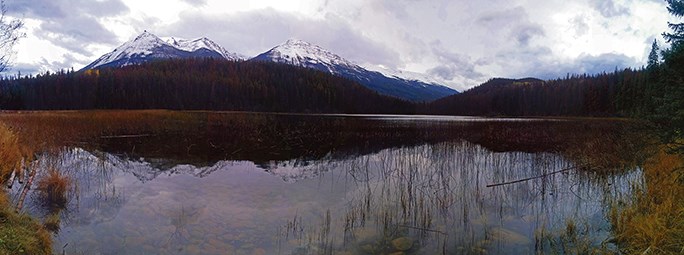By Craig Gilbert | [email protected]
They came from the forest, to the forest, for the forest.
A pair of out-of-province foresters with experience in Jasper National Park say they’re studying just how risky the fire risk is around the townsite.
Ken Hodges and Emile Begin, both RPFs, made the drive from Prince George to appear in the Quorum Room last month after writing a letter to Mayor Richard Ireland and council indicating that they are working on said study because they are worried the town could go up in smoke.
Council accepted the March 12 letter as information but the primary target of its 1,464 words was Parks Canada.
“The Fort McMurray Fire of 2016 was 500,000 hectares in size, [there were] 90,000 people evacuated and [it] cost over $9.9 billion (firefighting, lost revenue, lost property, etc.),” it reads. “The elephant fire in central BC, 2017 was 894,491 ha in size, 45,000 people evacuated; estimated firefighting costs only are around $382 million dollars. What will be the cost to fight a fire in Jasper National Park?”
They argue the Waterton Lakes National Park fire last summer is proof Parks is “unlikely able to address any mega fire situation arising that would ensure public safety (sic). Evidence confirms National Parks have not done their homework.”
Jasper National Park spokesperson Steve Young at the very least did his homework in responding to the critique.
In an email to the Fitzhugh Young wrote that Parks has been monitoring and managing the mountain pine beetle, which kills trees and creates drier, more volatile fuel for wildfire, since it appeared in JNP in 1999, and in 2015 formed a working group with Natural Resources Canada (NRCAN)/Northern Forestry Centre and the Government of Alberta (Alberta Agriculture and Forestry) to oversee the response.
He said Parks’ approach to wildfire risk management is based on the core elements of fire management planning: risk reduction, preparedness, prevention, response and prescribed fire. Alan Fehr, JNP superintendent, outlined it in a supplemental presentation at the park’s annual forum earlier this year.
Since 2003, more than 1,000 hectares of forest surrounding the town have undergone intensive forest fuel reduction through the FireSmart program to protect people and property in addition to community fire breaks.
“Parks Canada is moving forward with a plan for mechanical forest thinning on an area known as Pyramid Bench in November 2018,” Young said. “Crews will selectively remove the hazardous accumulation of dead pine trees west of the community caused by mountain pine beetle.”
Several prescribed fires planned for the spring of 2018 in JNP. The Fiddle Complex, located along the eastern park boundary, is a strategic firebreak to help prevent wildfire as well as manage the movement of mountain pine beetle beyond the park boundaries, according to Young. Conditions permitting, Parks Canada plans to burn the Fiddle Guard Unit and return to complete last spring’s prescribed fire in the Fiddle West Unit. A prescribed fire of the grasslands at Henry House is also planned.
“The safety of the public and staff, neighbouring communities and park infrastructure is always the Agency’s top priority.”
Some fire season resources
Fire risk: pc.gc.ca/jasperfireupdate.
Emergency preparedness: www.getprepared.gc.ca.
www.jasper-alberta.com/2350/Emergency-Preparedness
MPB: www.pc.gc.ca/en/nature/science/conservation/feu-fire/feuveg-fireveg/veg-veg/dpp-mpb




